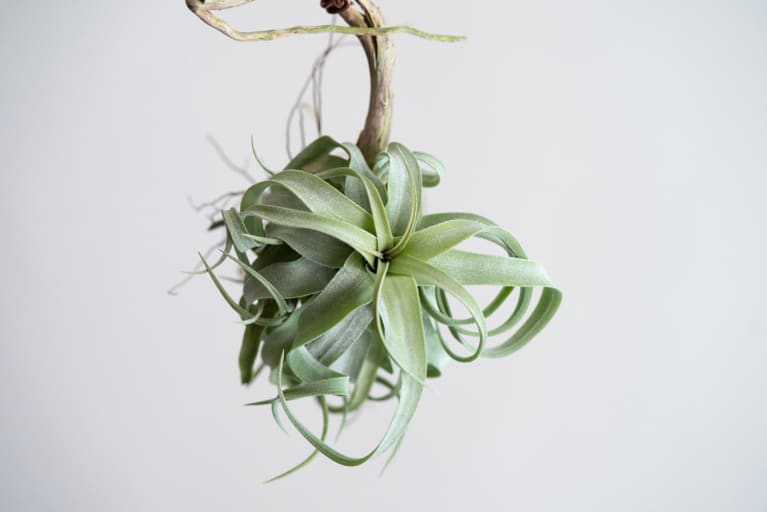
Our editors have independently chosen the products listed on this page. If you purchase something mentioned in this article, we may earn a small commission.
October 18, 2022 — 23:27 PM
Intrigued by air plants? These low-maintenance plants don’t require soil, meaning you can hang them from a string or pop them in a terrarium to add dimension and design to any room. We talked to three plant experts about air plant care for beginners.
Most air plants are part of the Tillandsia genus, with the majority of varieties making up part of the Bromeliad family (Bromeliaceae), just like the pineapple plant.
These tropical plants typically grow in humid regions, such as rainforests, in many areas around the world. Air plants can be found in Central and South America, as well as the West Indies, Mexico, and even in some areas in the southern United States. In the wild, you can find them growing in trees and crevices, as well as on rocks and cliffs.
Most air plants are epiphytes, meaning they rely on hard surfaces for stability but don’t require soil for nutrients. That’s because “Their leaves are covered in tiny hair-like structures called trichomes that help them absorb nutrients and moisture from the air,” Lindsay Pangborn, a gardening expert at Bloomscape, explains.
Despite their name, these plants don’t only subsist only on air. When keeping them as houseplants, you’ll need to water them too.
- Sunlight needs: Bright, indirect sunlight
- Where to put it: Hanging on a string, in an open terrarium, on a shelf
- When to water: Every 1- 2 weeks for 30 minutes
- Pros: Doesn’t need soil, easy to propagate
- Cons: Needs to soak for 30 minutes
- Pet-friendly? Yes; non-toxic to dogs and cats according to the ASPCA
- Size: Depending on the variety, they can reach between 5 inches to 10 feet in size
Caring for air plants at home.
When given the right conditions, these low-maintenance house plants will thrive. Here’s what you need to know to keep your air plant happy and help it bloom.
probiotic+
Tackle your gut issues now, so you don’t have to think about them later.*

As for how often to water your air plant, it’ll need water about 2-4 times a month. Pangborn explains that you can fill up the sink or bathtub with lukewarm water and let your air plant soak for around 30 minutes and “after soaking, lay it upside down to dry on a towel for 1-2 hours. This allows excess water between the leaves to drain away, which could otherwise cause mold or rot.”
Air plants also give off indicators when they’re thirsty. “The best way to know is to check your plant’s color and firmness,” says Naomi Robinson, Founder of Houseplant Authority. “If it’s a lighter color than normal combined with it being softer than usual, it’s time for a drink.”
If you’re wondering, how often you should mist your air plant, Robinson recommends once or twice a week during the warmer months, and once a month in winter.
In nature, air plants often grow on trees underneath a canopy, so it’s best to recreate this environment indoors with bright but indirect light. “Air plants thrive in bright indirect sunlight, which can be found in an eastern window or a few feet back from a southern or western window,” recommends Pangborn. Ideally, an air plant indoors will receive eight hours of indirect sunlight daily.
Paying attention to how much light your plant receives is important because too much or too little sun can cause issues. “Too much sun can cause unsightly sunburn, which appears as bleached areas of the leaves,” Justin Hancock, horticulturist at Costa Farms explains. “If they don’t get enough sun, they’ll slowly decline and die because they don’t have the energy to survive.”
“Air plants prefer a humid environment with temperatures ranging from 60-80°F,” says Pangborn. This makes them a suitable pick for indoor plants. The geographical region where you live will influence whether you can place your air plant outside. Some people may want to keep their air plant outside and bring it in during the cooler months, explains Robinson.
One of the benefits of air plants is they don’t need soil! But occasionally giving them a water-soluble fertilizer will help these plants grow faster and give them a better chance at blooming. “Giving your air plant some food helps to encourage it to produce ‘pups,’ which are the small offsets that come from the main plant,” says Robinson.
“You can use an orchid fertilizer, following the directions on the product packaging, or dilute a water-soluble houseplant fertilizer at about 10% of the recommended strength,” explains Hancock. Fertilize while watering your air plant. Pangborn adds, “It’s best to fertilize regularly during active growth times, like during the spring and summer months.”
Air plants produce flowers but will only bloom once during their lifetime. Flowers can last a few days or several months based on the variety. Once an air plant has bloomed, it should also start to produce pups.
The best way to propagate an air plant is to use those “pups”, or offsets that the main plant produces, explains Robinson. Here’s a step-by-step guide to propagating this plant:
- Removing a pup or offshoot once it reaches about ⅓ the size of the main plant.
- Hold the base of the plant and gently pull the offshoot from the mother plant. The pup should come off the plant easily. If it’s not easy or there’s resistance, grab a pair of scissors and snip the pup.
- Soak the offshoot in water and then place it in a spot with bright, indirect light.
- Now you have another air plant! Care for it in the same way as you do your parent plant.
You’re almost ready to go! Just consider these final tips for ensuring your air plant thrives.
- Avoid drafts: Make sure you keep air plants away from hot or cold drafts. “Don’t place them near heating or air-conditioning vents,“ Hancock says. “In nature, these plants aren’t exposed to blasts of air that are significantly warmer or cooler than the ambient temperature.”
- Have fun displaying them: “They tend to do well perched near windows, on shelves, on hanging trays, or even nestled in the branches of larger plants,” says Pangborn. You can get creative and hang them with string, too. Hancock adds, “Air plants can be hung with fishing line or a fine string to appear as if they’re suspended in the air.”
- Avoid closed terrariums: Air plants do best in open spaces where there is plenty of airflow. “When displaying air plants, it’s important to maintain some air circulation in order for them to thrive—they’re not suited for a closed terrarium or under a cloche,” explains Pangborn. Consider an open terrarium or containers with wide openings. Check out this guide to terrarium plants for more inspiration.
- Recreate the plant’s natural environment to promote pups: “The key to keeping any plant happiest is to try to replicate its natural environment as best you can,” says Hancock. Give yours plenty of bright, indirect light, occasional soaking, and some fertilizer, and it should produce pups a few months after blooming.
Ready to start sprucing up your home with fun and curious air plants? Follow these tips and you’ll have plenty of vibrant additions to your indoor jungle in no time.
Want to learn how feng shui can help you create a high-vibe home and set powerful intentions to manifest your dreams? This is feng shui the modern way – no superstitions, all good vibes. Click here to register for a free session with Dana that will give you 3 tips to transform your home today!
Reset Your Gut
Sign up for our FREE doctor-approved gut health guide featuring shopping lists, recipes, and tips
You are now subscribed
Be on the lookout for a welcome email in your inbox!
https://www.mindbodygreen.com/articles/air-plant-care

